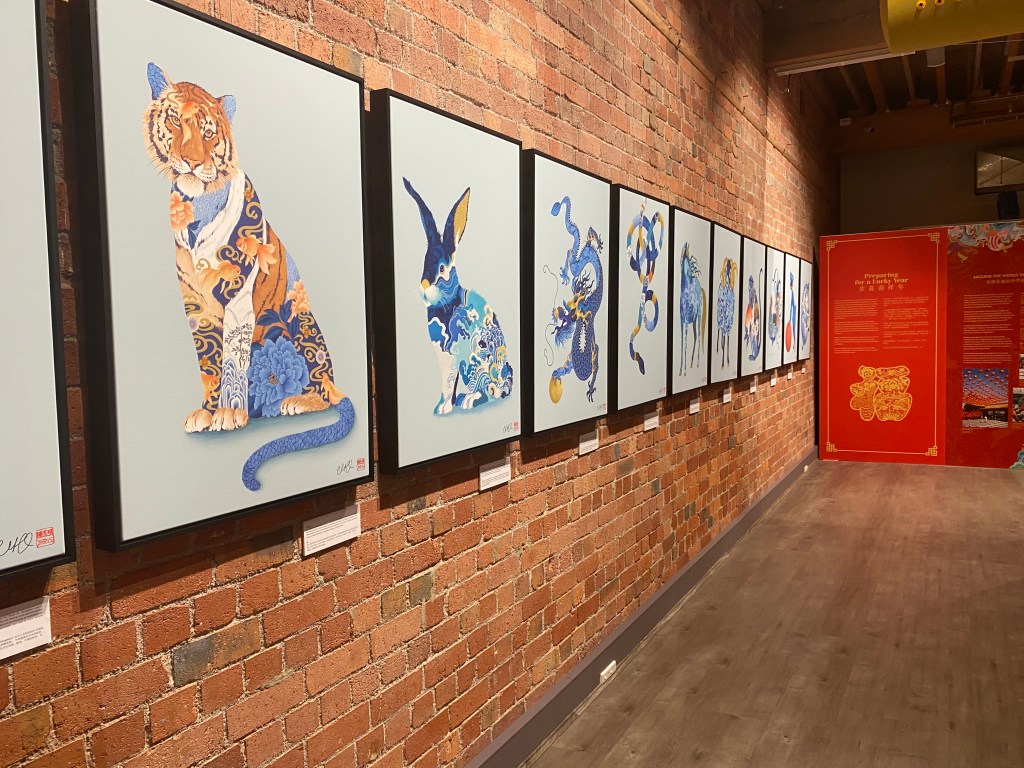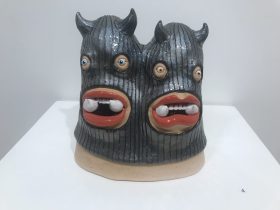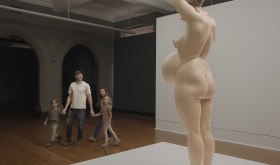Every year, in the lead-up to Lunar New Year, the Museum of Chinese Australian History has an exhibition showcasing a specific Australian Chinese artist. Previous artists include Master Hong, who specialises in Buddhist philosophies and arts. Due to COVID, they haven’t been able to run exhibitions in the past couple of years and have instead ran a series of events such as a Museum Open Day, dragon awakening ceremony and a dragon parade.
This year, it is Australian Chinese artist and textile designer Chris Chun, who is showing a series of artworks from his Chinese Zodiac 2023 series in an exhibition titled Lucky Rabbit. One of these notable artworks is simply called The Rabbit. With 2023 being the Year of the Water Rabbit, he says his aim in this exhibition is for his artworks to reflect the gentle nature of the rabbit, as well as the water element.
For those who haven’t been to the museum before, it’s a great opportunity – especially during the Lunar New Year – to also learn about the history of Chinese Australians, their settlement, culture and art, across five levels of exhibitions and galleries.
Chun’s exhibition is located on level one, with the delicate and detailed The Rabbit painting on the wall by the entrance to greet visitors. In the middle of the room, a vibrant and uplifting wishing tree already has many colourful paper slips hanging on it, each with handwritten new year wishes on them.
It’s a lovely attraction for children, and thoughtfully provided, with a table nearby for them to choose the colour paper they want to write their wish on. There are also colouring pencils and paper, helping to give parents a bit of peace to wander around the museum exhibits while their children are otherwise engaged.
There is one wall dedicated to the individual paintings of the 12 animals, from Chun’s Chinese Zodiac 2023 Series. In each animal painting, the influence of elegant Chinese blue and white ceramics can be seen, with graceful splashes of gold, red and orange throughout. In reading about the Lucky Rabbit in this section, we learn that it takes inspiration from the embroideries found on court robes from the Qing Dynasty: ‘The stylised waves and graceful water currents give way to the powerful dragon and the wise turtle.’
Without this note, it may not be obvious that those two animals feature within the rabbit painting. However, they can be seen by those who look carefully.
Around the perimeter of the exhibition room, educational displays hold information in gold writing against grand red boards. These displays help visitors acquaint themselves with the traditions, stories and history behind this significant cultural festival. There are many interesting facts and stories to read about, including how the rabbit symbolises peace and tranquillity for 2023, in contrast to the ferocious year of the tiger in 2022.
The ‘Preparing for a Lucky Year’ section explains rituals and superstitions, of what you should do to attract good energy and what you shouldn’t do leading up to the Lunar New Year to avoid bad luck.
The ‘Zodiac Wheel’ is a fun and interactive section, where people can find out the signs of who may be their ‘secret friends’, about who they may be compatible with, and perhaps make sense of why they may be foes with others. Again, it’s a section children can have fun with.
The display, ‘When You Wish Upon a Tree’ tells ‘The Legend of the Wishing Tree’, of how people around the world would place their wishes on this tree for the year ahead.
In the Origins of the Chinese Zodiac Animals section, each animal’s drawing is a story that tells of its role in ‘The Great Race’ and how each of the 12 animals earned their Zodiac year.
There is a wealth of interesting information about the Lunar New Year celebration at this exhibition, and there are stories with which even some Australian Chinese may not be familiar. Chun’s artworks provide a fitting, beautiful and peaceful backdrop to all this information. Perhaps some traditional Chinese music playing in the background could add to the cultural ambience.
The displays are provided in both Chinese and English.
Read: Lunar New Year events guide 2023
You can also learn more about Chinese Australian heritage and history by exploring the other levels of the museum. Most notable is the Finding Gold Exhibition, which features replications of real life scenes allowing visitors to immerse themselves into what it was really like for Chinese gold seekers in the Australian goldfields of the 19th century.
Lucky Rabbit – A Celebration of Chinese New Year, by Chris Chun
Museum of Chinese Australian History, Melbourne
Managing Curator: Rosemary Forde
Exhibition Design: Yue Yang
Research: Emilia Tagaza
Translation: Bruce Song
Tickets included in the normal admission price: $12.50-$31.50
Lucky Rabbit will be on display until 14 March 2023.





